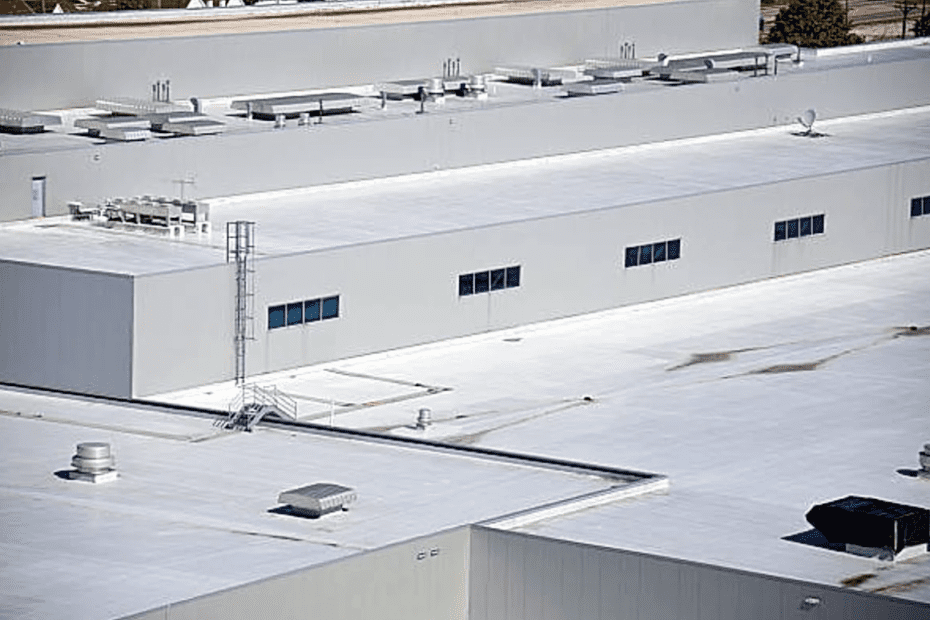Flat commercial roofing is different from the traditional shingles that many think of when you mention roofing projects. Due to the way that the roof is sloped, shingles are not possible on a flat top. The good news is that there are several options to choose from to fit your budget and needs.
Types of Traditional Flat Roofing Systems:
There are several different types of flat roofing systems that are long-term systems. These include:
- Built-Up Roof aka Hot Tar and Gravel Roofs: These types of roofs are one of the oldest. Hot tar is applied to the surface of the roof, and then it’s covered in gravel. These roofing systems can be expensive, but they have a long life.
- Single-ply Membranes, such as PVC, TPO, or EPDM: These roofing systems are relatively easy to apply, more affordable than some of the other systems, and have a decent lifespan of about 30-50 years or so depending on the exact product used.
- Modified Bitumen Membranes: This roof is a torch-down roof where heat is applied to make the upper layer stick to the lower layer. These systems can be more expensive than some other systems, but they also have a longer life expectancy at 40 plus years than the other less costly systems. Also, they may require less maintenance than other systems.
- Spray Polyurethane Foam-Based: These roofing systems can be beneficial, but they require a new coating of foam applied every 10 to 15 years. Proper maintenance of these roofs can result in a roof lasting 50 years or more.
- Metal Panels: Another older method of roofing. These systems are suitable for buildings with low slopes. A properly maintained metal roof can last between 40 and 50 years.
Some buildings are starting to use a live roof where the roof is covered with a system of tiles that support growing plants that offer several benefits. However, these roofs are relatively new and still rather rare than the more traditional roofing systems above.
Choosing A Roofing System:
Several factors go into deciding what roofing system is suitable for your flat roof. One factor is your current roof. You may want to continue using the same roofing materials used prior, especially if you’re only having your roof partially replaced or re-roofing. Another factor is the building itself. You may need to choose particular systems due to the building. Budget is another factor that comes into play when selecting a roofing system. Some systems are less costly when it comes to materials, labor, and other expenses. Another factor is maintenance, as some roofing systems need more than others. For instance, a spray polyurethane foam-based system needs to have regular maintenance every decade or so to ensure that it remains watertight and in good repair, while the different membrane systems don’t require as much routine maintenance.
Considering how to handle your subsequent flat roofing project? Contact Weather-Tite Exteriors to learn what material is best for your roof and get a quote. Don’t put off getting your flat roof repaired or replaced when there are various options for your roofing needs.
Flat Roofing Frequently Asked Questions
As a flat roof has a very slight pitch to it, some options don’t work for them at all, such as shingle roofs. Shingles aren’t recommended for flat roofs because the water sits on them rather than rolling off as it would on a pitched roof. That being said, there are several options when it comes to the best material for a flat roof. Some of the most popular choices for flat roofs are built-up roofs, modified bitumen roofs, and rubber membrane roofs. A built-up roof is a traditional hot tar and rock roof. A modified bitumen roof is a single-ply roof that is either torched down or peel and stick. A rubber membrane roof is one that is covered with rubber that looks similar to an inner tube. Each of these roofing systems has its own pros and cons, such as material durability, cost, maintenance, and how long it will last compared to other systems
The best way to determine which roofing system is best for your flat roof is to speak with a professional. They can examine your current roof, talk with you about your budget, and go over the best options available to you. Then, you can make an educated decision on which type of roofing system you want to have installed for your next flat roof.
There is a thought that flat roofs are bad, but there are pros and cons to any roof, like most things. One of the biggest cons to a flat roof is that snow and water can sit on it due to it not having much, if any, slope to it. Not getting regular inspections can mean that the drains can get clogged up, causing the drainage to be less than ideal. Poor drainage can result in damage to the roof that will need to be repaired. Another issue with having a flat roof is that dirt and debris can also pile up on top of the roof without cleaning and maintenance. This debris can cause problems, such as a pointy branch being able to poke a hole into the material, or it can also cause issues with the drains that prevent drainage. While these are all potential cons for a flat roof, they are typically quickly addressed through regular maintenance. There are quite a few things that are great about flat roofs, such as they can be easily maintained and are walkable, they can be very affordable, and they can even offer additional space, such as a place for solar panels.
Flat roofing systems do tend to cost less than pitched roofs, and you have a variety of materials to choose from. From both a material and labor standpoint, flat roof systems can be cheaper. In fact, they can cost under $5 per square foot for the materials alone, and when you combine the labor and other costs can be under $10 per square foot. On the lower end of prices, modified bitumen and spray foam roofing are two potential options for the cheapest. There are a few options at the higher end of costs, such as rubber, PVC, and TPO roofs. Even though they are more expensive, they are still relatively close in price. One thing to keep in mind is that while one system may be cheaper than the other when it comes to the installation, but there may be different trade-offs that you’re making, such as material lifespan. You may find that you may or may not want to select the cheapest flat roof system. Speaking with the professional roofers at Weather-Tite Exterior and getting quotes can help you find the best flat roof system possible for your particular needs and budget



